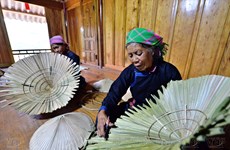More lithophones found in Dak Nong province
Local farmers found two lithophone sets on a pepper plantation in Long
Son commune in the Central Highlands province of Dak Nong on May 29.
Local farmers found two lithophone sets on a pepper plantation in Long
Son commune in the Central Highlands province of Dak Nong on May 29.
A spokesman for the provincial Department of Culture, Sports and Tourism said that one of the sets had 10 stone pieces, while the other had seven.
The department has taken charge of the instruments for preservation and further study.
The lithophone is an ancient musical instrument made from slabs of stone. It was first discovered in Dak Lak in 1949.
The ethnic people of the Central Highlands call the stone instruments goong lu, which means "rock gongs". They are an ancient percussion instrument from Vietnam and one of mankind's most primitive instruments.
The instrument is made of stone slabs of different sizes. The long, thick slabs sound bass notes, while the short, small, thin ones sound the higher notes.
The ancient people from the various mountainous regions in Southern Central and Southeastern Vietnam used the available rocks to create instruments.
Evidence of the lithophone dates back 10,000 years.
In 1956 a second set of rock gongs was discovered and brought to a New York exhibition by an American military officer.
The Cultural Space of the Gong in Tay Nguyen was recognised by UNESCO as a Masterpiece of the Intangible Heritage of Humanity.
Vietnamese archaeologists have been collecting and researching these stone instruments since 1979.
The third set was found in Lam Dong province in 1980. The instruments were preserved by a Ma ethnic family for seven generations.
In the early 1990s, 200 musical stone slabs were discovered in Dak Lak, Khanh Hoa, Dong Nai, Ninh Thuan, Lam Dong, Song Be and Phu Yen. Each instrument set contains three to 15 pieces.
The most famous sets of stone instruments are named after the places where they were discovered, which include Khanh Son, Bac Ai, Tuy An and Binh Da. Scientists say that the lithophone from Binh Da is about 3,000 years old.-VNA
A spokesman for the provincial Department of Culture, Sports and Tourism said that one of the sets had 10 stone pieces, while the other had seven.
The department has taken charge of the instruments for preservation and further study.
The lithophone is an ancient musical instrument made from slabs of stone. It was first discovered in Dak Lak in 1949.
The ethnic people of the Central Highlands call the stone instruments goong lu, which means "rock gongs". They are an ancient percussion instrument from Vietnam and one of mankind's most primitive instruments.
The instrument is made of stone slabs of different sizes. The long, thick slabs sound bass notes, while the short, small, thin ones sound the higher notes.
The ancient people from the various mountainous regions in Southern Central and Southeastern Vietnam used the available rocks to create instruments.
Evidence of the lithophone dates back 10,000 years.
In 1956 a second set of rock gongs was discovered and brought to a New York exhibition by an American military officer.
The Cultural Space of the Gong in Tay Nguyen was recognised by UNESCO as a Masterpiece of the Intangible Heritage of Humanity.
Vietnamese archaeologists have been collecting and researching these stone instruments since 1979.
The third set was found in Lam Dong province in 1980. The instruments were preserved by a Ma ethnic family for seven generations.
In the early 1990s, 200 musical stone slabs were discovered in Dak Lak, Khanh Hoa, Dong Nai, Ninh Thuan, Lam Dong, Song Be and Phu Yen. Each instrument set contains three to 15 pieces.
The most famous sets of stone instruments are named after the places where they were discovered, which include Khanh Son, Bac Ai, Tuy An and Binh Da. Scientists say that the lithophone from Binh Da is about 3,000 years old.-VNA













